Printable primary worksheets
All of our resources come complete with answer sheets to save time for busy teachers and parents. Input your child’s scores and keep track of your child's progress.
worksheet plans from £3.20/monthAll of our resources come complete with answer sheets to save time for busy teachers and parents. Input your child’s scores and keep track of your child's progress.
worksheet plans from £3.20/month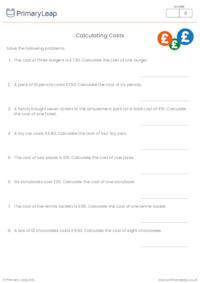
Calculating costs activityWith this maths worksheet, students will solve problems related to calculating costs. They will use their knowledge of integer multiplication and division facts to find missing values.
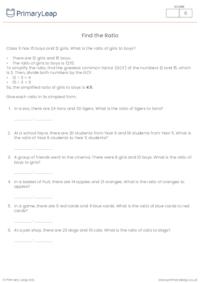
Find the RatioThis maths worksheet is tailored to reinforce students' understanding of ratios and proportions. The worksheet includes problems where students will determine the ratios between different quantities. They will work with real-life scenarios to calculate and express these ratios. The worksheet is designed to help students practise finding and expressing ratios as well as simplifying them when necessary. This worksheet is an ideal resource for Year 6 students looking to enhance their skills in working with ratios and proportions.
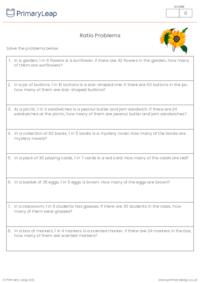
Ratio problems worksheetThis maths resource focuses on ratios, specifically designed to help students develop a strong understanding of these concepts. The worksheet includes problems where students will practise finding and simplifying ratios. They will work with real-life scenarios such as zoo animals, classroom students, and more, calculating the ratios and simplifying them to express the relationships between different quantities. This worksheet aims to reinforce essential skills in solving problems involving ratios, making it suitable for students looking to enhance their proficiency in this topic.
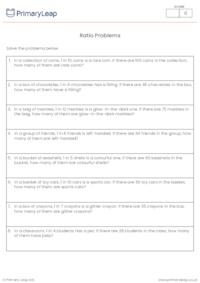
Ratio problems worksheetThis maths activity focuses on ratios and proportions, specifically designed to help students develop a strong understanding of these concepts. The worksheet includes problems where students will practise finding and simplifying ratios. They will work with real-life scenarios such as zoo animals, classroom students, and more, calculating the ratios and simplifying them to express the relationships between different quantities. This worksheet aims to reinforce essential skills in solving problems involving ratios, making it suitable for students looking to enhance their proficiency in this topic.
 Free
Free
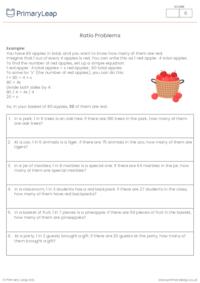
Ratio problems worksheetThis Year 6 math worksheet focuses on ratios and proportions, specifically designed to help students develop a strong understanding of these concepts. The worksheet includes problems where students will practise finding and simplifying ratios. They will work with real-life scenarios such as zoo animals, classroom students, and more, calculating the ratios and simplifying them to express the relationships between different quantities. This worksheet aims to reinforce essential skills in solving problems involving ratios, making it suitable for students looking to enhance their proficiency in this topic.
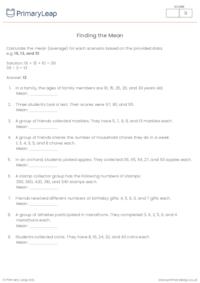
Finding the Mean with ScenariosThis worksheet iprovides Year 6 students with opportunities to practise calculating the mean (average) within the context of various real-world scenarios. Students will use whole numbers to calculate the mean based on different sets of data related to scenarios involving friends, activities, and collections.
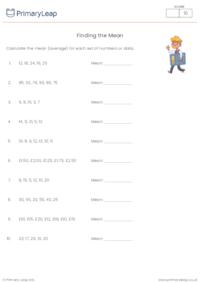
Finding the MeanThis handy worksheet will help students practise and master the skill of finding the mean (average) of a set of numbers or data. Students will work with various sets of data, both numerical and categorical, to calculate the mean and express it as a numerical value. By working with various sets of data and practising the calculation of the mean, students will enhance their numeracy skills and develop a solid grasp of the concept of average.
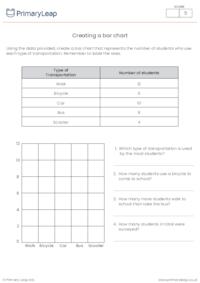
Creating a Bar ChartThis worksheet aims to engage students in the process of creating a bar chart based on real-world data. Students will use the provided data and scenario to construct a bar chart and then answer questions related to the chart. This activity fosters data representation and analysis skills.
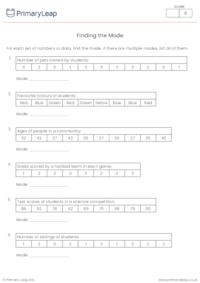
This worksheet is intended for use in the classroom, as a homework assignment, or as part of a larger unit on statistics and data analysis. Mode is the value that appears most frequently in a dataset. Students will work with a range of numerical sets and data scenarios to calculate the mode, including the possibility of having multiple modes.
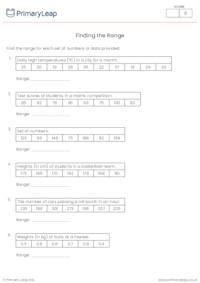
Use this worksheet to help students deepen their understanding of the concept of "range." Range is the difference between the largest and smallest numbers in a set of data. Students will work with larger numbers and more complex data sets to calculate the range in various scenarios.
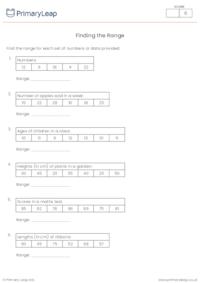
Practising RangeUse this worksheet to help students practise the concept of "range," which is the difference between the largest and smallest numbers in a set of data. In this worksheet, students will work with both numbers and data sets.
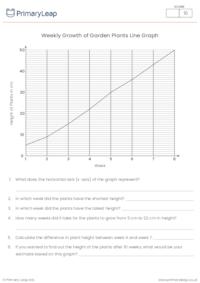
Weekly Growth of Garden Plants Line Graph ActivityUse this worksheet to help students practise interpreting data from a line graph. Students will analyze a line graph representing the weekly growth of plants in a garden and answer questions related to the graph. This worksheet can be used in the classroom, as a homework assignment, or as part of a larger unit on data analysis and interpretation. It aims to improve students' skills in reading and understanding line graphs while engaging them with real-world data related to plant growth. There are 10 questions for students to answer.
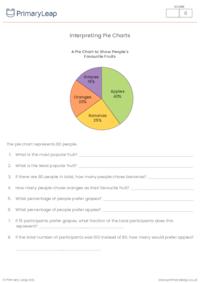
Interpreting Pie ChartsThis worksheet is designed to engage students in exploring data visualization through a pie chart. Students will work with data representing the favorite fruits of a group of participants. They will interpret the data in the form of a pie chart and answer questions related to the chart.Pupils will:Understand how to interpret and analyse data presented in a pie chart.Identify the most and least preferred fruits among participants.Practise calculating percentages based on the pie chart data.Work with fractions in the context of data analysis.
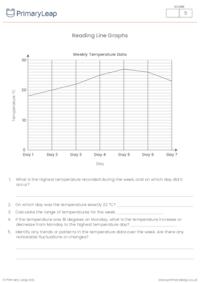
Reading Line GraphsUse this handy worksheet to help students practise interpreting and analysing data presented in a line graph. The line graph displays temperature data over the course of a week. Students will engage with the graph to answer questions that require them to identify temperature trends, extremes, and averages within the dataset. This worksheet can be used effectively in the classroom for interactive learning. Educators can provide guidance and facilitate discussions as students work on the questions. It is also suitable for homework assignments, allowing students to practise their data analysis skills independently. This activity can be a valuable addition to the curriculum for reinforcing data analysis and visualisation skills, both in the classroom and as homework.
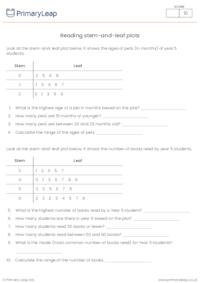
Reading stem-and-leaf plotsThis worksheet is designed for students to practise interpreting stem-and-leaf plots. Stem-and-leaf plots are a visual representation of data that help us understand the distribution of values within a dataset. In this activity, students will work with data related to the number of books read by year 5 students. They will answer questions to analyse the information presented. This activity can be a valuable addition to the curriculum to reinforce data analysis and visualisation skills.
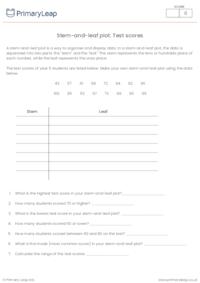
What is a stem-and-leaf plot? A stem-and-leaf plot is a way to organise and display data. In a stem-and-leaf plot, the data is separated into two parts: the "stem" and the "leaf." The stem represents the tens or hundreds place of each number, while the leaf represents the ones place.Students create their own stem-and-leaf plot using the data on the worksheet. After creating their plot, they answer seven questions based on their plot. This activity will help students understand what a stem-and-leaf plot is and practise creating their own plots based on given data. The questions aim to reinforce their knowledge and interpretation of stem-and-leaf plots. Review the answers with the students to ensure their comprehension of the concept.
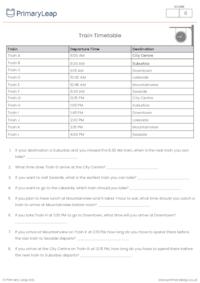
Train Timetable for a Day ActivityThis worksheet is designed to challenge students in reading and interpreting train timetables while promoting critical thinking and time management skills. Students will be required to analyse the provided train schedule and answer questions that involve planning journeys, calculating travel times, and making connections.
 Free
Free
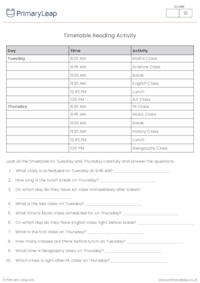
Timetable Reading ActivityThis worksheet will help pupils practise reading and interpreting timetables. In this activity, students will use the provided activity timetables for Tuesday and Thursday to answer a series of questions that require careful observation.
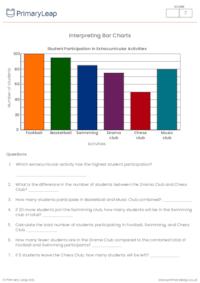
Extracurricular Activities Bar Chart WorksheetThis handy maths worksheet will help students develop their skills in reading and interpreting bar charts while providing engaging questions related to student participation in various extracurricular activities. The bar chart represents the number of students involved in different clubs or activities. There are seven questions that require students to analyse the bar chart data and use critical thinking skills. Questions include comparisons between activities, calculating differences, and adding and subtracting participation numbers.
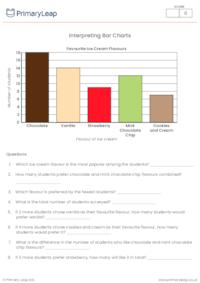
Interpreting Bar ChartsThis worksheet is designed to help students develop their data-handling skills using a bar chart. Students are presented with a bar chart that displays the favourite ice cream flavours of a group of students. They will need to interpret the chart and answer a series of questions that involve reading and understanding the information presented in the chart.
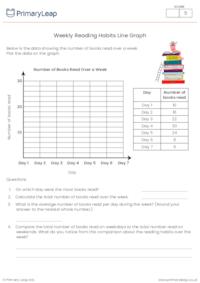
Weekly Reading Habits Line GraphThis worksheet is designed to help students practice interpreting line graphs while gaining insights into weekly reading habits. The graph presents the number of books read over a week, with days on one axis and the books read on the other. Students will answer questions related to the graph, such as identifying the number of books read on specific days, determining the day with the most books read, calculating the total books read over the week, and finding the average daily reading.Additionally, students are encouraged to think critically about possible reasons for fluctuations in the data, including any significant increases or decreases in books read on particular days. This worksheet aims to develop students' data interpretation and critical thinking skills.
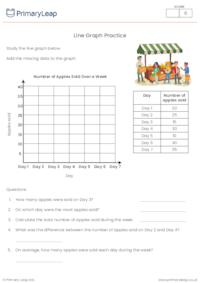
Line Graph PracticeThis worksheet helps students improve their skills in interpreting and creating line graphs. By using the example of apples sold over a week, students will enhance their abilities to collect and represent data. After completing the graph, students will answer questions to assess their understanding. These questions include interpreting data, identifying the day with the most sales, finding the total apples sold, comparing sales on specific days, and calculating the average daily sales. This maths resource can be used in class, for homework, or as part of a broader unit on data handling and graphs.
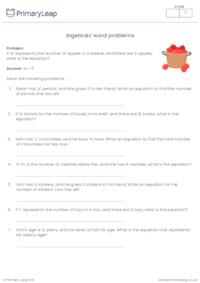
This Year 6 maths worksheet focuses on developing algebraic problem-solving skills through word problems. The worksheet consists of 7 word problems that challenge students to translate real-life scenarios into algebraic equations. Each question is designed to encourage critical thinking and strengthen their understanding of algebraic concepts.
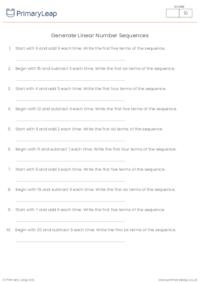
This KS2 maths worksheet focuses on helping students practise generating linear number sequences. Linear sequences follow a consistent pattern in which each term is obtained by adding or subtracting the same fixed amount from the previous term. This worksheet provides various sequences with different rules, including addition and subtraction, and challenges students to identify and write the first few terms of each sequence. The worksheet contains a set of 10 questions, each with a unique linear sequence, and includes a mix of addition and subtraction rules. The answers to all questions are provided to assist educators in assessing students' progress and understanding of linear sequences. This activity is designed to enhance students' skills in recognising, generating, and describing linear number patterns, a fundamental concept in algebra and mathematics.
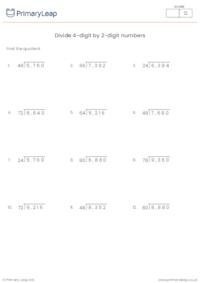
Divide 4-digit by 2-digit numbersThis worksheet is designed to help Year 6 students practise division with numbers up to 4 digits divided by a two-digit whole number without any remainders. These problems will reinforce their division skills and help them become more confident in performing long division. Students can use these exercises to improve their proficiency in solving division problems efficiently.
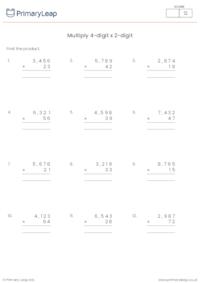
Multiply 4-digit x 2-digit activityThis multiplication worksheet is designed for Year 6 students to enhance their multiplication skills through 12 challenging problems. Each problem involves the multiplication of 4-digit numbers by 2-digit numbers, providing a valuable opportunity for students to practise and reinforce their mathematical understanding.
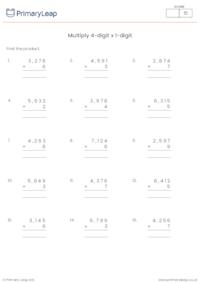
Multiply 4-digit x 1-digitThis multiplication worksheet is designed for Year 6 students to reinforce their multiplication skills by working with 4-digit numbers multiplied by 1-digit numbers. The worksheet includes a total of 15 multiplication problems involving 4-digit numbers and 1-digit numbers. This maths resource will help to: Enhance students' ability to multiply 4-digit numbers by 1-digit numbers.Develop strong mental math and problem-solving skills.Reinforce multiplication principles with real-world applications.This resource can be used in the classroom for practice, homework assignments, or as part of a maths assessment.
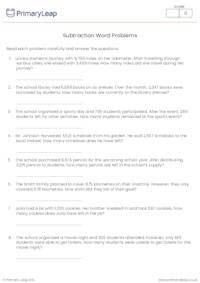
Subtraction word problemsThis resource is ideal for practising subtraction skills in a meaningful and practical way. It promotes critical thinking, problem-solving, and the application of mathematical concepts in everyday scenarios. Use this resource for classroom activities, homework assignments, or extra practice to reinforce subtraction skills.
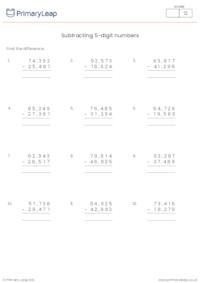
Subtracting 5-digit numbers in columnsThis worksheet is designed for Year 6 students to practise and enhance their skills in 5-digit column subtraction. The worksheet consists of 12 problems, each involving the subtraction of one 5-digit number from another. These problems are crafted to challenge students and reinforce their understanding of subtraction with larger numbers.
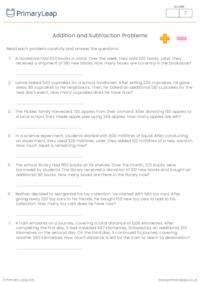
Addition and Subtraction Multi-step Word ProblemsThis worksheet will help to reinforce students' skills in solving real-world problems involving addition and subtraction. Each problem presents a unique scenario where they'll need to apply their mathematical understanding to find the solution.
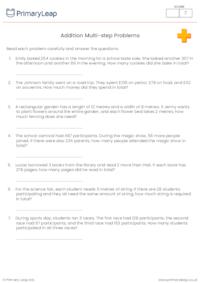
Addition Multi-step ProblemsThis Year 6 worksheet is tailored to enhance students' skills in solving multi-step addition problems within various real-world contexts. Challenge students with multi-step problems that require the application of addition skills at various points in the problem-solving process. Suitable for group activities, partner work, or individual practice during math lessons.
 Free
Free
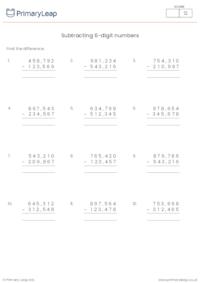
Subtracting 6-digit numbers in columnsThis year 6 maths resource provides structured and engaging practice, allowing students to confidently tackle the subtraction of 6-digit numbers with two addends. Strengthen proficiency in the column subtraction method, a crucial skill for advanced mathematical concepts. Ideal for in-class practice sessions, homework assignments, or revision to reinforce subtraction skills.
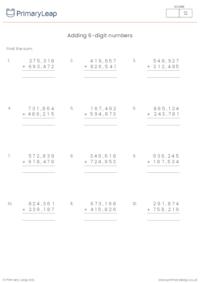
Adding 6-digit Numbers with 2 AddendsEmpower your Year 6 students with this handy maths resource designed to elevate their addition skills. This worksheet focuses on adding two 6-digit numbers, providing targeted practice to reinforce mastery of the column addition method. Pupils concentrate on adding two large numbers, allowing them to develop confidence and proficiency in the column addition technique. Ideal for in-class practice sessions, homework assignments, or revision to reinforce addition skills.

Adding 5 and 6-digit numbers (4 addends)This Year 6 maths resource is crafted to inspire students with challenging addition scenarios, promoting a deeper understanding of column addition and preparing them for more advanced mathematical concepts. Ideal for in-class challenges, encouraging collaborative problem-solving and critical thinking.
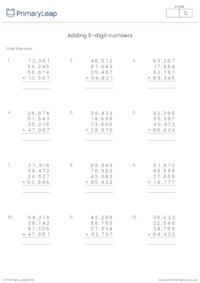
Adding 5-digit numbers with 4 addendsElevate your Year 6 students' addition skills with this maths resource focused on adding 5-digit numbers with four addends. This worksheet offers targeted practice to reinforce the mastery of column addition while introducing complexity through the incorporation of four addends. Challenge your pupils today! The answer sheet is included for quick marking.

How will this worksheet help my child?Addition word problems help students develop problem-solving abilities, critical thinking, and mathematical reasoning. These skills are vital for their academic success and will help them solve problems encountered in everyday life. Engage your students in real-world problem-solving with this word problems worksheet focused on addition. Suitable for in-class practice, homework assignments, or revision to reinforce addition skills.
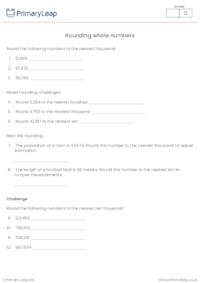
Rounding whole numbersThis maths worksheet is carefully designed to provide a systematic and engaging approach to rounding numbers to various degrees of accuracy. Through a series of exercises and challenges, students will refine their rounding skills and gain a deep understanding of the principles behind this fundamental concept. Students will gain mastery in rounding whole numbers to different degrees of accuracy, reinforcing their understanding of place value. Suitable for in-class practice, homework assignments, or revision to reinforce rounding skills.
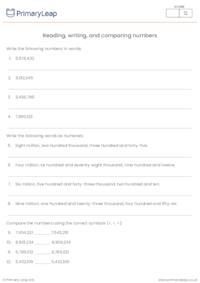
Read, write, and compare numbers up to 10,000,000Introduce your Year 6 students to the world of large numbers with our comprehensive worksheet designed to enhance their skills in reading, writing, and comparing numbers up to ten million. This engaging resource offers a variety of exercises to solidify their understanding and boost their confidence in handling large numbers. Ideal for reinforcing classroom learning, providing additional practice, or serving as homework assignments. Watch your students excel as they confidently navigate the world of ten million and beyond.
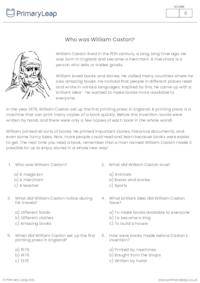
William Caxton Comprehension ActivityThis short comprehension introduces KS1 students to William Caxton and highlights his contributions to the world of printing, emphasising how his invention made books more accessible for people to read and learn. There are 6 multiple-choice questions that aim to assess students' grasp of key details in the text.
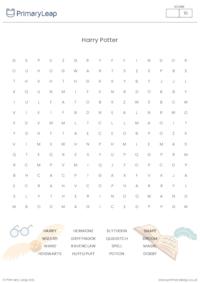
Harry Potter Word Search ActivityEncourage students to find these magical words hidden in the puzzle. It's a great way to celebrate Harry Potter Book Day and engage young fans of the wizarding world!When is Harry Potter Book Day?Harry Potter Book Day takes place on the 12th of October, but you can celebrate on any day that suits you after the 12th of October too!
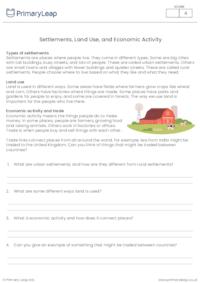
Settlements and Economic ActivityWith this KS2 geography worksheet, students will learn about different types of settlements, how land is used, and the important concepts of economic activity and trade links. Let's dive into the fascinating world of settlements and economic activity. Settlements are places where people live, and economic activities are all the things people do to earn a living.
 Free
Free
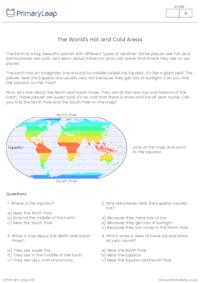
The World's Hot and Cold AreasThis colourful engaging worksheet will help pupils identify the location of hot and cold areas of the world in relation to the Equator and the North and South Poles. Students read through the text and answer the multiple-choice questions.
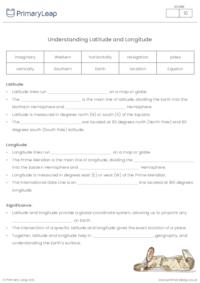
Latitude and Longitude Cloze ActivityThis engaging cloze activity is designed for KS2 students to reinforce their understanding of latitude and longitude. By completing the missing words in sentences, students will enhance their comprehension of these geographical coordinates.
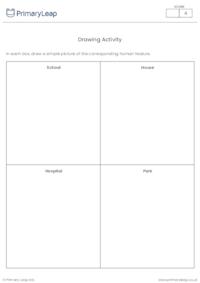
Human Features Drawing Activity This drawing activity aims to help students visually represent and understand various human features within their community.
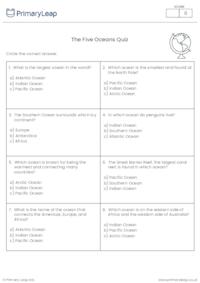
Explore the Oceans Quiz for KS1 PupilsThis quiz isn't just about finding the right answers - it's a journey to explore our amazing oceans! Pupils learn which ocean is the biggest, discover where penguins live, and find out that some oceans are warm while others are icy. Children read through the questions and circle the correct answer from the options (a, b, or c).
 Free
Free
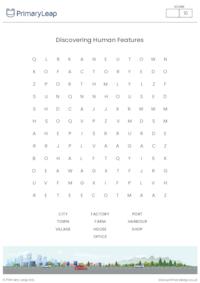
KS1 Human Features word search activityEmbark on a fun and educational journey with this engaging KS1 word search! This activity is designed for young learners to discover and recognise various human features in their surroundings. The following words are hidden within the puzzle: city, town, village, factory, farm, house, office, port, harbour, and shop. Students search horizontally, vertically, and diagonally to find each hidden word.This word search not only enhances vocabulary but also introduces young learners to diverse human features, fostering an early understanding of the various places where people live, work, and engage in daily activities.

The Five Oceans Vocabulary CardsUse these vocabulary cards to spark curiosity about the world's oceans. Each card provides the name and location of one of the five oceans. Whether used in classrooms or homeschooling settings, they provide an engaging resource for geography lessons, homework, vocabulary building, or matching activities.
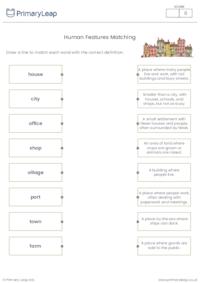
Human features matching activityThis matching activity asks students to match the descriptions of each human feature with the correct name. This will help learners use basic geographical vocabulary to refer to key human features, including: city, town, village, farm, house, office, port, and shop.




Check out our ready-to-use worksheets that can be used in the classroom or at home. Simply download or print and watch your child’s confidence grow with our easy to follow printables.


One of the best things about printable worksheets is that they make learning fun and easy. Explore our educational resources based on and keep your children learning through these fun and engaging exercises.


Our printable worksheets are designed for progressive learning. Our engaging content enables a child to learn at their own speed and gain confidence quickly. When we help a child believe in themselves, we empower them for life.


Printable worksheets are a great way to enhance creativity and improve a child’s knowledge. Help your child learn more about with this great selection of worksheets designed to help children succeed.
An email has been sent to your account please activate your account to continue.

PrimaryLeap has introduced a new interactive learning platform and would like to offer you a completely Free Upgrade.
We understand that you may only want to use our services for worksheets and may not want to upgrade your account.
But if you are interested in trying out our new services then you're just a click away.
An email has been sent to your account please activate your account to continue.
You've answered
and have 2 Questions remaining
Import multiple students information through a CSV File. Browse or drag .CSV file below.